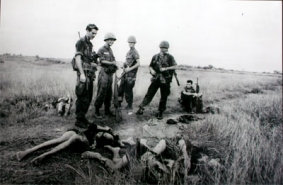
After a heavy raid, US troops were unflinchingly eating, drinking and smiling beside the bodies of civilians they killed. A traffic accident could haunt me, but these troops were too used to killings. (1967, Ground Force Division 25 in Tay Ninh)
Born in Okinawa, Japan, Ishikawa Bunyo started realizing his dream of travelling all over the world by working for an American company specializing in trading cinematography and documentary film facilities in 1964.
Some months later, as the Gulf of Tonkin incident happened on August 4, 1964 when US troops officially joined the Vietnam War, Ishikawa was assigned to capture images of this expeditionary force in the S-shaped country. He could not imagine that this mission would be his destiny and would turn a new page in his life. He spent days and months following the American troops’ operations which claimed the lives of many people branded by the US troops as “Vietcong guerrillas”.
Ishikawa Bunyo was attracted by the development of the Vietnam War’s events and became a witness with experience in collecting news from the battlefield, because he had spent a long period of time with American troops.
As a photographer, he captured images of the war with his own compassion and strangely convincing lens.
A series of his photos depicting the cruelty of the war appeared in different newspapers in the 1960s and Ishikawa Bunyo went into the history of world photography as a witness to the cruelty and savagery of war, and the indomitable spirit of the Vietnamese people.
More than 1,000 photos taken during his days going with US troops and the Saigon puppet troops introduced in his more than 500-page book vividly reflect the truth of the war.
Viewers could practically smell the gunpowder, the burnt human flesh, and the blood of innocent people.
Here are some photos taken by Ishikawa Bunyo.

A heart-broken mother as her child is being arrested and taken away by the Army of the Republic of Vietnam. (1967, an operation in Ba Xuyen)

US soldiers fought in muddy, windy and sandy areas and thick forests, wearing down their spirits and health. (1966, Cavalry Division 1 in Binh Dinh)

After fierce attack by the liberation troops, what was left on Hill 875 Dac To, including rows of burnt trees and an embittered US soldier. (1967, in Kon Tum)

Women doing irrigation work. (in Thai Binh)

Vietnamese women playing an important role in the fight for national salvation. These women were as gentle as the Cuu Long River and were resilient in the fight against enemies.
Translated by Ngoc Bich
Source: qdnd.vn






